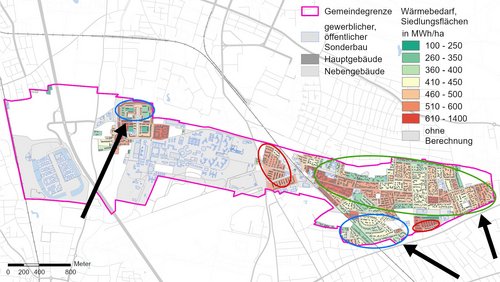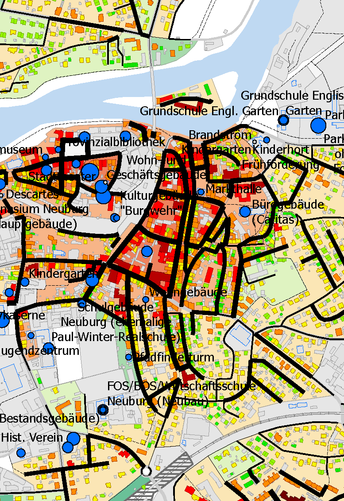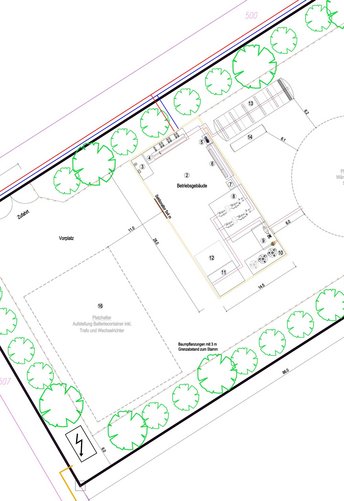Summarised results of the partial energy use plan drawn up by bifa Umweltinstitut August 2024
Summary of the results of the partial energy utilization plan prepared by the bifa environmental institute September 2024

Introduction
Climate protection is an important field of action for the municipality of Neubiberg. The municipality has committed itself to achieving a climate-neutral administration by 2030 and aims to achieve overall climate neutrality by 2040 at the latest. The heat supply is an essential field of action here: it is responsible for around half of the greenhouse gas emissions within the municipality. In view of this, the municipality commissioned the bifa environmental institute to prepare a study in which the heat supply situation is recorded in detail, potentials are identified and targeted measures are proposed.
Current situation
The inventory showed: Neubiberg has a natural gas network that covers almost the entire area. Three district heating networks have so far primarily supplied large public sector customers, commercial customers and large residential complexes. A municipal heating register was calculated from building-specific heat demand assessments. Energy and CO2 balances were drawn up for the private household, commercial/service and public building sectors and broken down by energy source.
Potential
Energy-saving potential is a significant lever for reducing greenhouse gases. Savings avoid the dilemma of limited renewable energy sources, reduce the effort required to generate and distribute energy, and permanently reduce operating costs. It is recommended that ambitious progress be made in each individual case wherever possible. Nevertheless, even with intensive renovation, a heating and hot water demand will remain, which must then be covered by renewable energy sources. The renewable heat generation potential in the municipal area was determined. Notable expansion potential was identified for solar energy, near-surface geothermal energy (ambient heat) and, in particular, deep geothermal energy. Based on the local geological conditions, deep water from the Upper Jurassic Malm at a depth of 2,800 meters can be expected to have a temperature of around 110°C.
Expansion of the heating network
District heating systems can make a significant contribution to the comprehensive conversion of the heating supply to renewable energies. As a rule, renewable energy sources can be used more efficiently in integrated heating solutions than for individual building heating systems. In addition, new developments can be quickly integrated into heat generation. A community-wide, web-based survey was conducted to determine the interest in connecting to district heating and the conditions of building owners. 593 responses could be evaluated. 69 percent of the owners are interested in connecting to district heating immediately or within the next 5 years, another 22 percent are interested in later. The main opportunities are seen in the security of supply and low investment costs. In contrast, heating prices, contract durations and the availability of the connection are seen as risks.
The plans of the operators of existing district heating networks were discussed in interviews. These also served as a basis for developing the recommendations for action.
Climate protection scenario
Taking into account the potentials, a climate protection scenario was developed that describes the heating supply situation after a structural change in the heating system has taken place and is the target vision for the development. The climate protection scenario is based in particular on the following approaches:
- The use of biomass remains at today's level and is therefore not expanded.
- Solar thermal energy contributes a significant share of water heating and heating support.
- Decentralized environmental heat (air, water, soil) covers the majority of the supply of buildings that are not or will not be connected to a heating network.
- The existing heating networks are being redensified and expanded as far as possible.
- The district heating offers are essentially based on geothermal energy.
- Smaller area networks supplement the existing heating networks.
Action strategy
Measures to achieve the climate protection scenario have been drafted, reviewed and substantiated. The proposed strategy for action comprises three priorities:
heating networks
- support for the densification and expansion of existing heating networks
- initiation of the planning and construction of a new central heating network
- initiation of local heating networks (local heating solutions).
Renovation
- organization of a consulting campaign for building owners
Climate-neutral municipal administration
- Updating the municipal energy management system for the continuous energy-related optimization of municipal properties
- Commissioning of an energy concept for a planned youth recreation center
- Commissioning of an energy-efficient renovation concept for a kindergarten
The bifa results were presented to the environmental committee and the municipal council and discussed in detail. The municipality implemented the first measures within the project period.
The study was funded by the Bavarian State Ministry of Economic Affairs, Regional Development and Energy as part of the Bavarian funding program for energy concepts and municipal energy use plans through Bayern Innovativ GmbH, project management agency for Bavaria.
![[Translate to Englisch:] Placeholder](/fileadmin/_processed_/f/4/csm_Header_Presse_d565a61df7.jpg)

